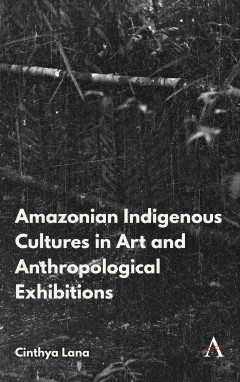Amazonian Indigenous Cultures in Art and Anthropological Exhibitions
By Cinthya Lana
- About This Book
- Reviews
- Author Information
- Series
- Table of Contents
- Links
- Podcasts
About This Book
The book discusses the representation of Amazonian indigenous cultures in temporary exhibitions taking place between the 1980s and 2010 through the analysis of selected case studies of these exhibitions held in major institutions in Europe, South America and the United States, including the British Museum, Musée du Quai Branly, Centre George Pompidou, Museum of Modern Art of New York, São Paulo Biennial and São Paulo Art Museum. Drawing on extensive archival research, the book is richly illustrated and presents a range of exhibition documentation never published before.
The book takes as a starting point the theoretical discussions that emerged in the 1980s stimulating the development of notions of ‘decolonising’ or ‘indigenising’ the museum as well as of practices of collaboration between museums and indigenous communities. Forty years on from the outset of these debates, the book proposes a critical inquiry on how these discussions inflected on exhibition practices in the following decades, focusing in particular on how ‘major’ institutions (ethnographic museums, art museums and art biennials) have responded to these debates.
The results of the research suggest that practice has fallen behind theory and that most ‘major’ institutions or museums within Europe and the United States are still only marginally engaging with Amazonian indigenous peoples in the organisation of exhibitions. The book advances the concept of ‘minor curating’ as a strategy to potentiate access of indigenous peoples to historical collections held by major institutions and to facilitate the development of cultural projects with these collections and in ways that are culturally, historically and politically effective. The book has an interdisciplinary reach contributing to the fields of visual anthropology, curatorial studies, museum studies and exhibition history and covering a geographical area that has been overlooked within these fields.
Reviews
This ground-breaking work uses extensive archival research and informative illustrations to bring Amazonia-focused exhibitions to life under an astute, critical gaze combining anthropology, art history and museum studies. The thought-provoking analysis opens a new window on how we represent others and how they might be given the space to represent themselves. —Stephen Hugh-Jones, Honorary Emeritus Associate, King’s College, University of Cambridge, UK.
Cinthya Lana’s book surveys how different political, intellectual and artistic paradigms have influenced the presentation of Amazonian cultures in exhibitions. By comparing exhibitions taking place across European, North and South American museums, Lana guides the reader to suspect the neutrality of curatorial and institutional discourses, exposing underlying processes of exclusion, prejudice and racism in contemporary exhibition practices. As a curator myself, I have been an observer of how collections have been used and manipulated for political purposes, both historically and today. Fundamentally the book questions how exhibitions showcasing objects, histories and cultural elements of others can still be produced without a deeper involvement of the people concerned. — Adriana Muñoz, Curator of the Americas, National Museums of World Culture, Sweden.
Amazonian Indigenous Cultures in Art and Anthropological Exhibitions is a powerful contribution to the urgent debate over representation of Indigenous peoples in exhibitions. Through nuanced interrogation of museum archives and oral histories, Lana brings influential exhibitions back to life through generous illustrations and informed critique. She connects exhibition theory and practice to broader movements in art history and anthropology showing how, even where intentions are good; the voices of Amazon rainforest peoples are invariably marginalized. Ending with proposals for different ways of working, this important book will surely find a wide readership among all those interested in how museums, art and anthropology can truly serve Indigenous peoples, in the Amazon and beyond. — Mark Nesbitt, Curator of Economic Botany and Senior Research Leader at Kew, Royal Botanic Gardens, UK.
This is a solid work inspired by Cinthya Lana’s earlier ethnographic research carried out among the Waiwai in northeastern Amazon. Lana has a great knowledge of the collections of Indigenous peoples from Brazil held in many European museums, acquired especially during her doctoral and postdoctoral research at King’s College London and at the National Museum of Brazil respectively. Lana has actively collaborated with the project of reconstruction of ethnographic collections for the National Museum of Brazil since the fire in 2018. I am very happy this excellent and very original research is becoming a book and accessible to a wider audience. — João Pacheco de Oliveira, Professor of Anthropology at the Postgraduate Program in Social Anthropology of the Federal University of Rio de Janeiro, and Curator of Ethnographic Collections at the National Museum of Brazil
Author Information
Cinthya Lana is a researcher at the University of Gothenburg developing a project of digital repatriation of Brazilian collections from the Swedish Museum of World Cultures (Världskulturmuseet), as well as opening the collections for long-term research to indigenous students from the Amazonian region.
Series
Anthem Brazilian Studies
Table of Contents
Abbreviations; List of Figures; Foreword; Acknowledgements; Introduction; Chapter One, Primitivism and Magiciens: The Amazon in the Art World; Chapter Two, Contemporary Cannibalisms: The 24th Bienal de São Paulo; Chapter Three, The Hidden and the Unknown: Amazonian Exhibitions at the British Museum; Chapter Four A Subdivided World: The Amazon in the Musée du quai Branly’s Comparative Exhibitions; Conclusion; Notes; References; Index
Links
Stay Updated
Information
Latest Tweets



